Service of training and communications aircraft of the Third Reich in the post-war period
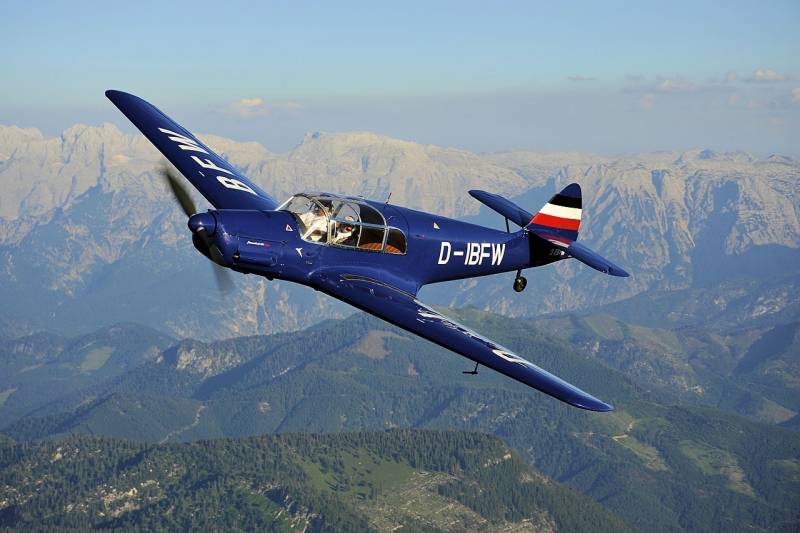
German fighters, bombers and reconnaissance aircraft are widely known. However, the light training and multi-purpose aircraft of the Luftwaffe often remain outside the attention of a wide range of readers. A number of aircraft for this purpose, due to their good flight and performance characteristics, were used after the end of World War II, and some aircraft were produced in the post-war period.
Multi-role aircraft Arado Ar 79
Little known is the Arado Ar 79, a two-seat multi-role aircraft that went into mass production in 1938. A series of 180 aircraft was initially planned. But due to the overload of the German aircraft industry with military orders, a total of 72 aircraft were built.
The low-wing monoplane had retractable landing gear and streamlined shapes. The aircraft has a maximum take-off weight of 760 kg, equipped with an in-line air-cooled Hirth HM 504A engine with a power of 105 hp. s., in horizontal flight it could accelerate to 230 km/h, cruising speed was 195 km/h. Practical flight range – 1 km. The service ceiling is 025 m. A specially prepared specimen with enlarged fuel tanks set a range record in its class. The distance of 5 kilometers was covered without stopping at an average speed of 500 km/h.
The Ar 79 was initially advertised as an aircraft for personal ownership, but after the outbreak of World War II, most of the aircraft built began to be used in flight schools and for courier mail delivery.
At the end of 1938, Hungary received 14 Ar 79 aircraft of modifications B and D. There they flew in paramilitary flying clubs and as part of the Air Force. Four Hungarian Ar 79s remained in service until 1955.
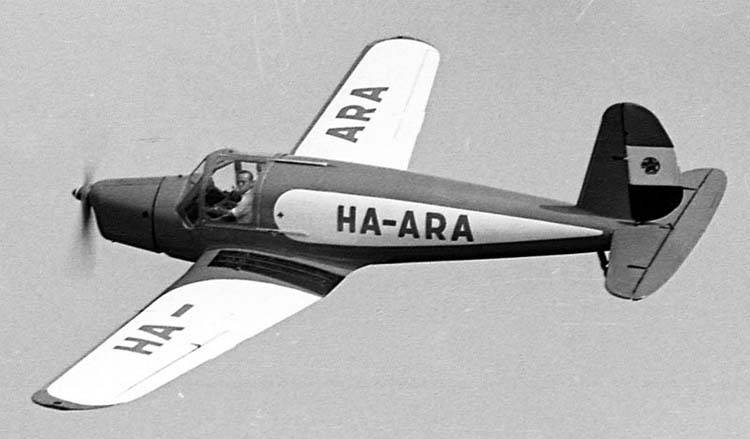
Hungarian Ar 79
Several more aircraft that survived the war were operated in Germany. The last aircraft of this type, after a radical restoration using modern materials, flew until 2001.
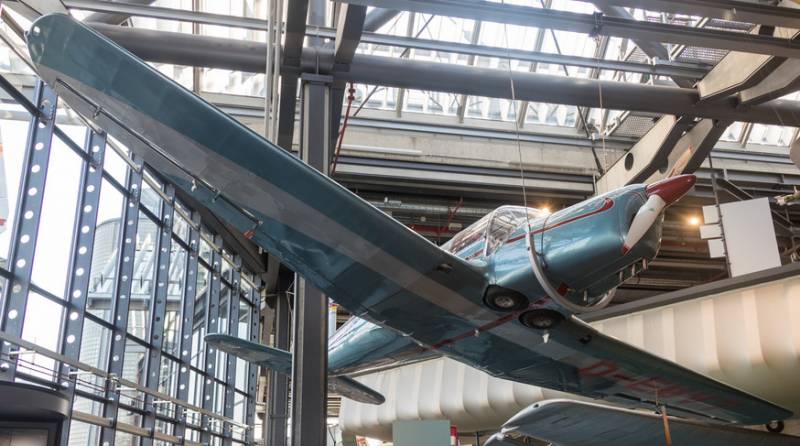
This Ar 79 is currently on display at the Berlin Museum of Technology and Transport.
Arado Ar 96 training aircraft
The Arado Ar 96 was designed specifically for training and training pilots of fighters, attack aircraft and bombers, which became the most famous training device created by Arado Flugzeugwerke GmbH.
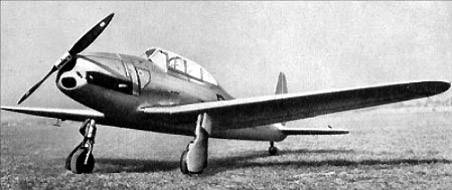
Arado Ar 96
The Arado Ar 96 trainer, which made its first flight in 1938, turned out to be very successful, and the total number of aircraft produced exceeded 11 aircraft. The prototype, which had an all-metal construction made of light alloys, was equipped with an 500-cylinder in-line Argus As 8C engine producing 10 hp. With. The main landing gear retracted into the wing.
In 1939, the initial batch of Ar 96A production aircraft was manufactured. In 1940, a large order for improved Ar 96B aircraft was received by the Junkers branch at the Oschersleben aircraft plant. In mid-1941, the Czech company Avia began production of the Ar 96. The construction of the Ar 96 was also carried out by Ago Flugzeugwerke, part of the Heinkel concern, and in 1944 the production facilities of the Czech company Letov were used.
Production Ar 96B aircraft were equipped with a 12-cylinder Argus As 410A engine producing 465 hp. With. With such an engine, the two-seater car reached a speed of 330 km/h. Cruising flight speed is 295 km/h. Maximum take-off weight – 1 kg. Practical range – 810 km. Service ceiling – 990 m.
To train shooting skills, some aircraft were equipped with a 7,92 mm MG 17 machine gun. Holders for small aerial bombs could also be mounted, which, in case of emergency, made it possible to use the Ar 96 as a light attack aircraft. A modification of the aircraft for aerial rifle training was also produced, distinguished by the presence of a movable MG 15 machine gun installed in the rear cockpit.
Simplified all-wood airplane Ar. 396 with Argus As 411 engine producing 580 hp. With. produced since 1943.
Ar. 96 was the main German trainer aircraft during the Second World War. The Luftwaffe used Ar. 96 in their flight schools, fighter training wings, refresher squadrons and officer schools for advanced flight training, night instrument flight training. During the Second World War, Ar. 96 formed the basis of the aviation fleet of training fighter squadrons.
In the post-war period, the exploitation of surviving Ar. 96 took place in Germany, Hungary, Bulgaria, Poland, Czechoslovakia and France. Moreover, Avia continued to build the Ar. 96 in the post-war period. In the Czechoslovak Air Force, these training aircraft were designated Avia C.2B.
Production in Czechoslovakia continued until 1948, with aircraft being delivered under the designation Avia C.2. Several dozen of these training devices also arrived in Bulgaria and Hungary. In addition to direct pilot training, Avia C.2 aircraft were used to tow gliders and aerial targets, as well as to deliver urgent mail and small cargo.
Avia C.2 training aircraft were operated in Czechoslovakian flight schools until December 1958, after which cadet training continued on Soviet Yak-11s. The Avia C.2 flew in Hungary until 1961, and in Bulgaria until the early 1990s.
After liberation from the German occupation, the French company SIPA (Societe Industrielle Pour l'Aeronautique) began serial production of Ar aircraft. 396 as S.10 for the French Air Force. At the same time, some of the equipment in the cockpit became French, and the German 7,92 mm MG 17 machine gun was replaced by the French 7,5 mm MAC 34/39.
A total of 30 examples were built.
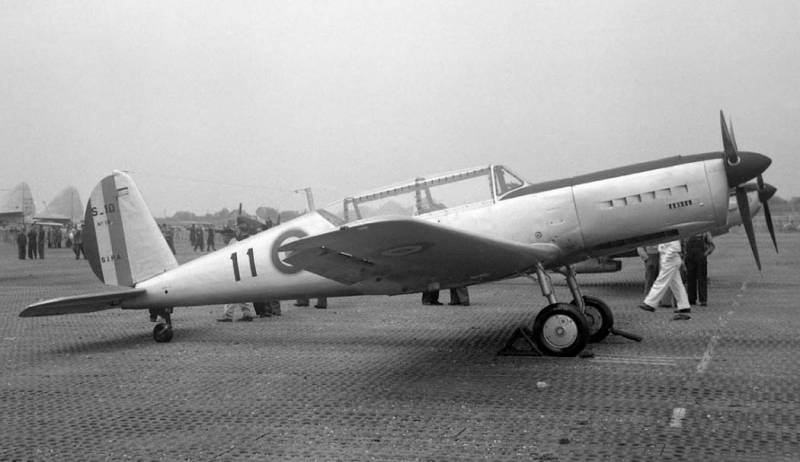
The maximum take-off weight of the aircraft was 2 kg. Horizontal speed – up to 071 km/h. Practical range – 370 km.
In 1946, SIPA submitted the S.11 aircraft for testing, which was a modified version of the Ar. 96. After eliminating the comments identified by representatives of the Air Force, the multi-purpose aircraft entered service under the name S.111, and a contract was signed with the manufacturing company for the supply of 54 aircraft.
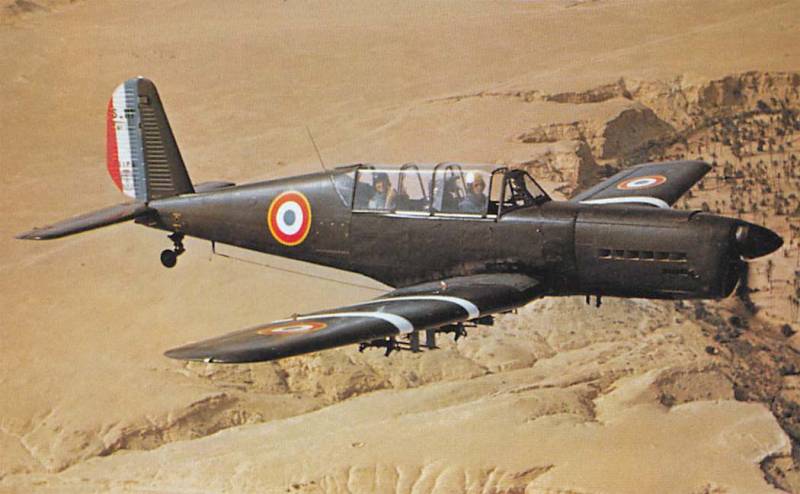
S.111A
Production S.111A aircraft received two 7,5 mm machine guns with 600 rounds of ammunition per barrel. As well as two holders for light bombs (usually one 50-kg or four 10-kg in a block) and two guides for Matra T10 unguided rockets under each wing.
The aircraft is powered by a Renault 12S-00 engine (French version of the German Argus As 411) with a power of 580 hp. With. had a maximum take-off weight of 2 kg. The maximum speed was 070 km/h, cruising speed was 368 km/h. Practical range – 320 km. Service ceiling – 700 m.
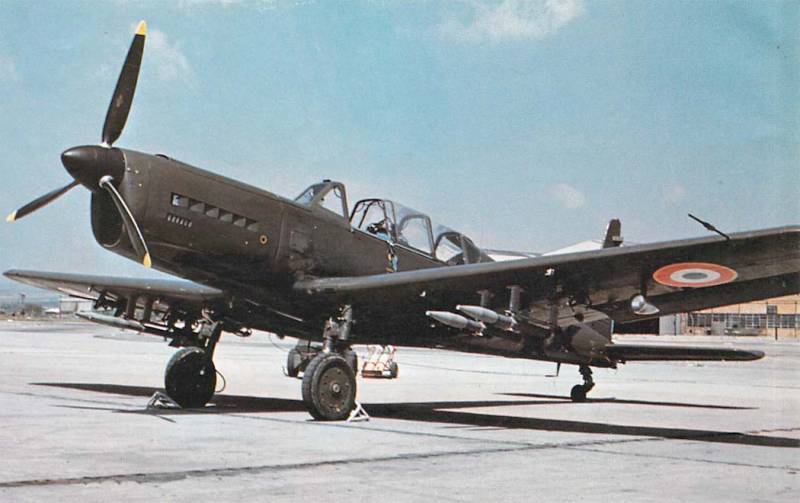
In the late 1950s, S.111As took part in the Algerian war. At the initial period of hostilities, the rebels did not have anti-aircraft weapons, and until a certain point the aircraft were successfully used as reconnaissance aircraft, spotters, and even light attack aircraft.
Having gained experience in operating the S.10 and S.111A, the French Air Force command demanded a return to an all-metal fuselage. The new version of the aircraft was designated S.12. To compensate for the increased weight to 2 kg, a 335-horsepower SNECMA 600S-12 engine was installed on it.
In 1951, 52 S.12 and S.12A aircraft were produced. The S.12A modification retained the weapons set of the S.111A and was also used in Algeria.
The lightweight all-metal version was designated S.121. The production of this car began in 1951, a total of 52 copies were built.
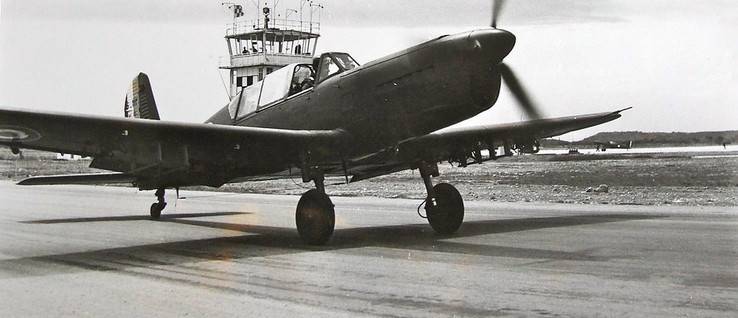
S.121
Thanks to the reduced weight of the airframe, this modification had improved flight characteristics. Increasing the volume of fuel tanks made it possible to increase the flight range to 1 km. Some of the aircraft were equipped with weapons.
Active operation of the S.12 and S.121 in France continued until the early 1970s.
Training aircraft Bücker Bü 131 Jungmann
Since 1935, the Bücker Bü 131 Jungmann biplane has been widely used for initial pilot training in Germany. This aircraft is notable for being the first production aircraft of Bucker Flugzeugbau GmbH and the last two-seat biplane trainer adopted by the Luftwaffe.
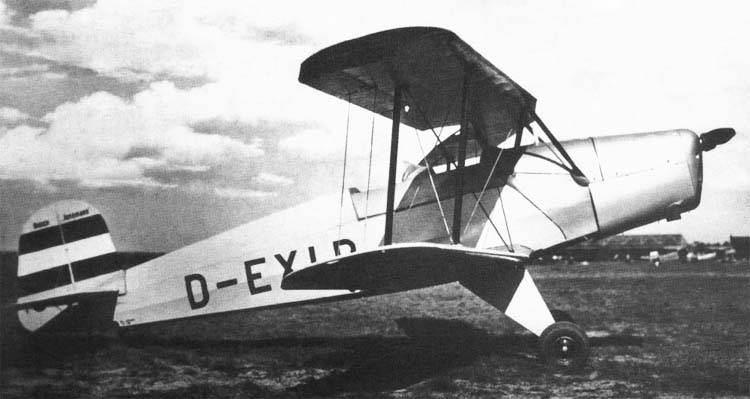
Bü 131A
The Bü 131 was a typical biplane, with slightly swept wings. The fuselage frame is made of steel pipes, the cabin trim and engine hood are made of light alloys, and the rest of the trim is made of fabric. The wing's strength elements are made of laminated wood and covered with fabric.
The aircraft first flew in April 1934. During operation, the Bü 131 has proven itself to be a very reliable, durable and easy to operate machine. The Bü 131 trainer was used not only in Germany, but was also exported to 23 countries and built under license in a number of countries. According to reference data, more than 5 of these biplanes were assembled.
The largest importers were Yugoslavia, Hungary, Bulgaria and Romania. Approximately 90 aircraft were assembled under license in Switzerland. More than 500 aircraft were built at the Spanish factories of the CASA concern. In Czechoslovakia, the Tatra company produced 10 aircraft before the war, known as the Tatra T.131.
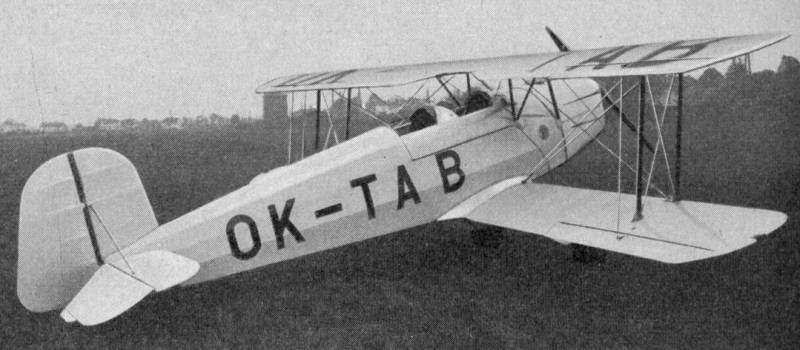
Tatra T.131
During the years of German occupation, production of the Bü 131 in the Protectorate of Bohemia and Moravia continued at the Aero plant. Mass production under license was carried out in Japan, where 1 Kokusai Ki-037a aircraft were built and entered service. aviation Imperial Army. In Japanese naval aviation, these training biplanes were designated K9W1 Momiji.
The first Bü 131A were equipped with a Hirth HM 60R engine with 80 hp. With. In 1936, production of the Bü 131B began with a Hirth HM 504A-2 engine producing 105 hp. With. The aircraft with a maximum take-off weight of 680 kg could reach a speed of 183 km/h in horizontal flight, and a cruising speed of 160 km/h. Practical range – 650 km. Practical ceiling – 300 m.
In addition to flight schools, aircraft of both modifications were used at the front in night bomber units and to fight partisans.
In the post-war period, serial construction of the Bü 131B was carried out in Czechoslovakia. Aircraft powered by the Hirth HM 504A-2 engine are known as the Aero C-4. Biplanes equipped with a Walter Minor 4-III engine were designated Aero C-104.
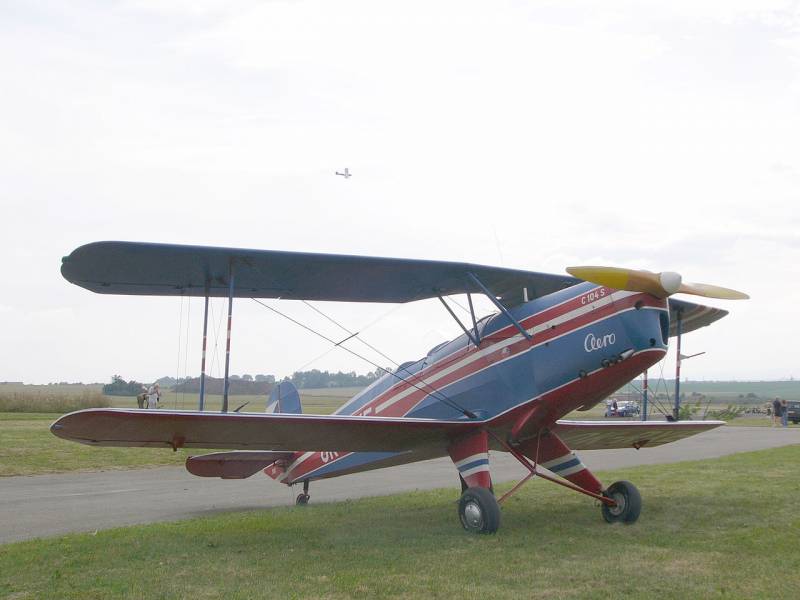
Aero C-104
In the 1960–1970s, Spain, Czechoslovakia and Switzerland began selling off their Yugmans, which still had significant residual life.
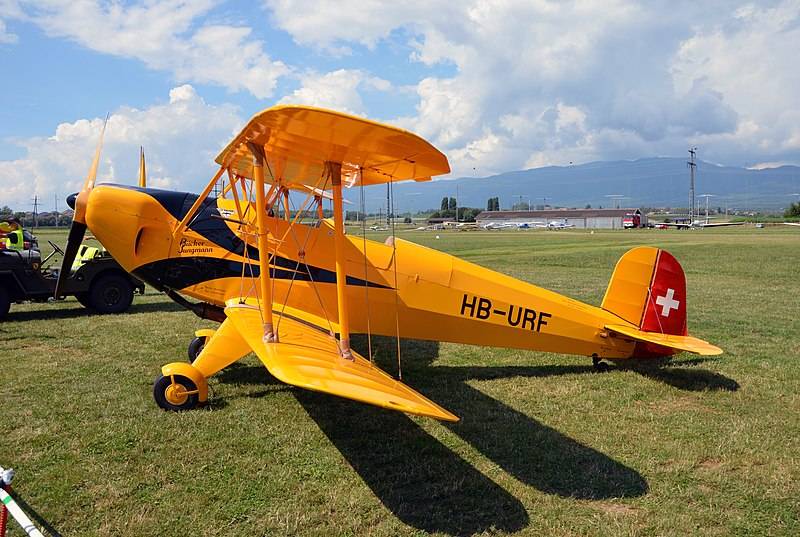
The main buyers were individuals from the United States. About two hundred rare biplanes have still been preserved, many of which have been radically refurbished and equipped with modern four-cylinder Lycoming O-320 (150 hp) or O-360 (180 hp) engines with fuel and oil systems adapted for performing intensive aerobatics.
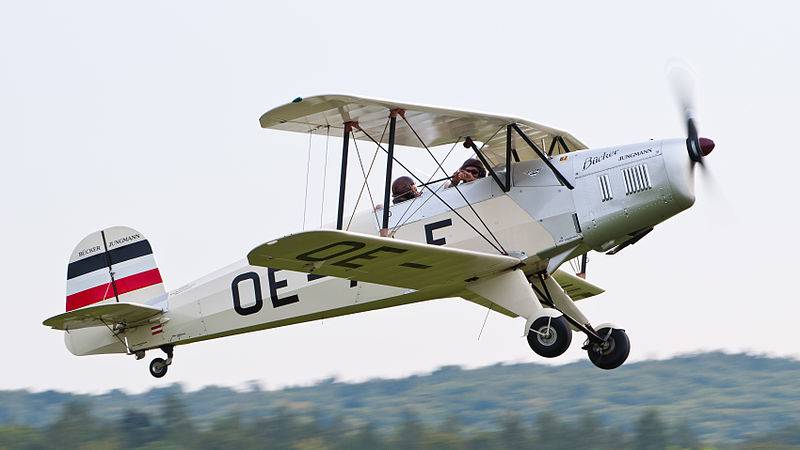
Very often, these aircraft take part in various aviation shows, where they invariably attract the attention of spectators.
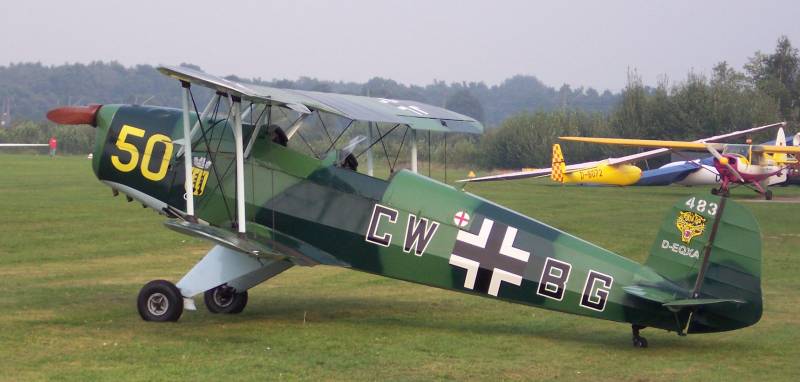
Due to the fact that the Bü 131 biplanes are still in demand among buyers, in Poland in the late 1990s a small-scale assembly of the modern version of the Jugman was carried out, which received the designation SSH T-131PA.
Aerobatic aircraft Bücker Bü 133 Jungmeister
Soon after the creation of the two-seat Bü 131, a single-seat biplane, the Bücker Bü 133 Jungmeister, was designed on its basis, which was originally intended to perform aerobatic maneuvers.
The Bü 133A differed from its two-seat predecessor in its smaller size, Hirth HM 6 engine with 135 hp. With. and reinforced construction. The reduction in size combined with a more powerful engine had a positive effect on flight performance. Based on the results of tests completed in 1935, the vehicle was recommended for launch into mass production as an aircraft for advanced training of pilots and initial training in air combat.
Following the Bu 133A model, the Bu 133B modification aircraft appeared with a Hirth HM 506 engine producing 160 hp. With. However, the most advanced and famous was the acrobatic aircraft Bü 133C, equipped with a Siemens Sh 14A-4 radial engine with a power of 160 hp. With.
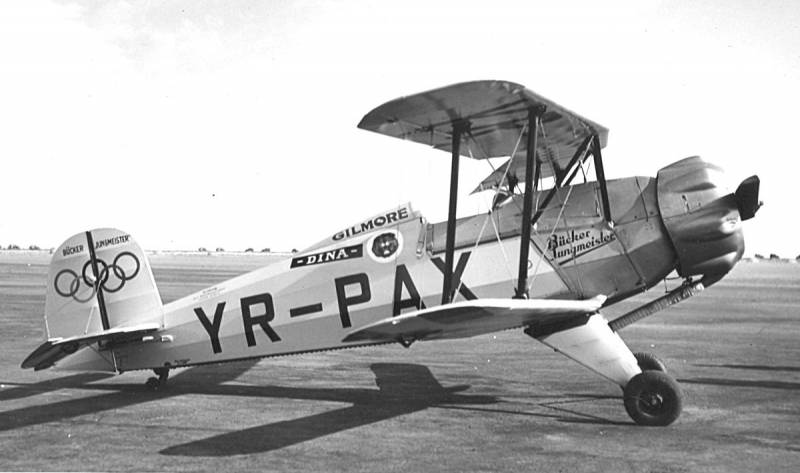
Bü 133C
This modification had a maximum take-off weight of 585 kg. Maximum flight speed is 220 km/h. Cruising - 195 km/h. Practical range – 500 km. Service ceiling – 4 m.
At the time of its introduction, the Bü 133 was the best aerobatic aircraft in the world. Its production in Germany lasted from 1935 to 1941. In total, about 250 examples were built.
After the end of World War II, production of the Bü 133 resumed in Switzerland and Spain. The Swiss version is known as Do/Bu 133, the Spanish version is known as CASA 1.133.
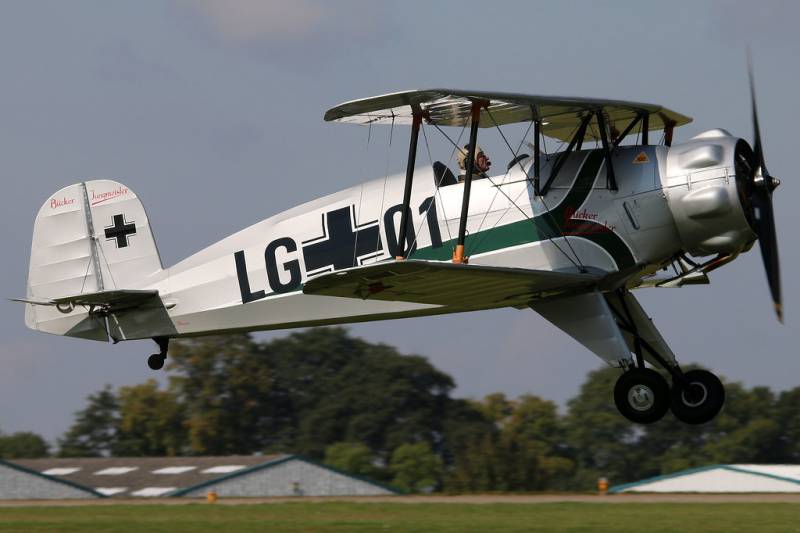
HOME 1.133
Production of CASA 1.133 continued until 1970, and these aircraft were sold to more than 20 countries.
To this day, the original Jungmeisters, as well as the Swiss and Spanish clones, are considered first-class acrobatic machines.
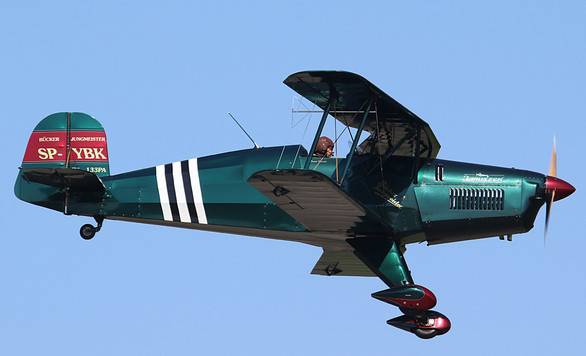
On aircraft participating in demonstrations and competitions, German engines are in most cases replaced by other power plants, as a rule, these are modern American engines produced by Lycoming Engines and Teledyne Continental Motors.
Multi-role aircraft Fieseler Fi 156 Storch
The Fieseler Fi 156 Storch was a unique aircraft of its kind. The strutted top-wing monoplane was capable of operating from very short runways.
The prototype Fi 156-V1, tested in 1935, demonstrated that it needed 13 m to take off in a headwind of 15 km/h, and 18 m to land. Such takeoff and landing characteristics were achieved thanks to Handley Page automatic slats (55% wingspan) and the so-called “rotating wing” (a flap that extends back and down and increases the wing area by 18%).
At the same time, “Storch” was simple and cheap to manufacture. The fuselage was a spatial form, welded from steel pipes and covered with fabric on the outside, the two-spar wooden wing was covered with fabric, and the tail was covered with plywood. If necessary, the wing could be folded.
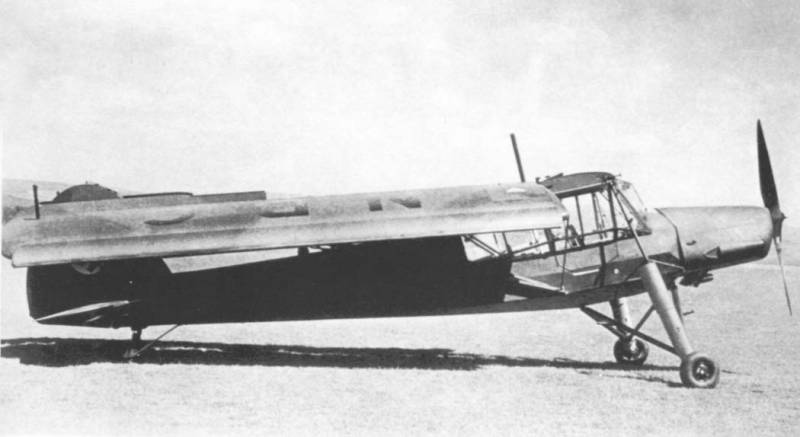
The non-retractable landing gear was strong enough for use on uneven surfaces. In winter, the wheels were replaced with metal skis with guy cords. The skis are equipped with an original mechanical brake to reduce mileage. A small ski is also put on the crutch.
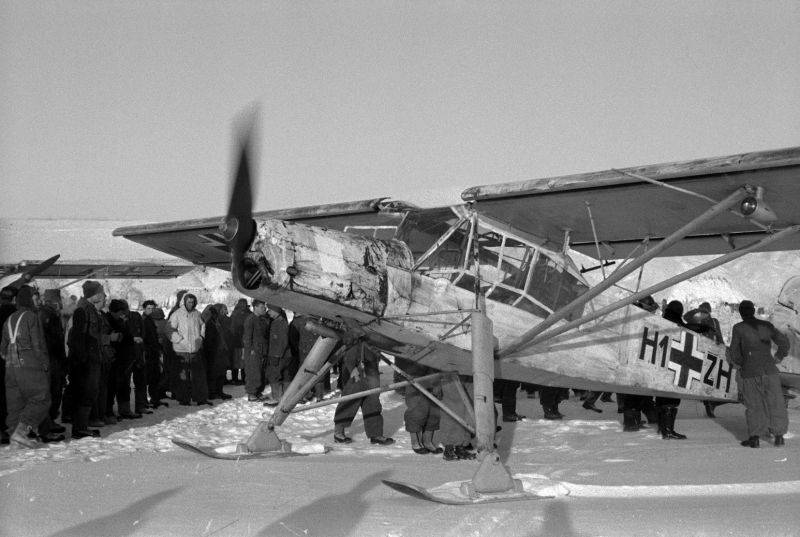
After testing four prototypes, the Luftwaffe command in 1936 concluded that the Fi 156 was excellent for short-range reconnaissance, surveillance and communications. In 1937, ten Fi.156A-0 experimental series were tested by troops. During testing, it was found that the aircraft, weighing 1 kg, maintained controllability at speeds of up to 240 km/h, and with a sufficient headwind, it literally hovered in the air in one place. During testing in medium winds, the aircraft landed on a plowed field with a run of 50 meters.
In addition to reconnaissance and communications, the Fi 156 demonstrated the ability to deploy smoke screens and targeted cargo drops. The aircraft could be used for anti-submarine patrol of the sea and carry a 135-kg depth charge under the fuselage, and as a light bomber with a 50-kg bomb under the fuselage and two of the same bombs under the wing. For targeted bombing from a shallow dive, aiming marks were used on the windshield.
At the beginning of 1939, after the correction of the problems identified during operation, the production of aircraft of the “C” series began. The Fi 156C-2 modification, intended for use in short-range reconnaissance squadrons, had a normal take-off weight of 1 kg. Air-cooled engine Argus As 325C-10 with a power of 3 hp. With. provided a maximum flight speed of 240 km/h. Cruising speed – 175 km/h. Practical range without an additional tank is 150 km. Ceiling – 385 m. Crew – 4 people.
There was also an additional folding passenger seat. To protect the rear hemisphere there was a 7,92-mm MG 15 machine gun. However, an unarmed Storch under the control of an experienced pilot was a very difficult target; high maneuverability and the ability to hover in the air in most cases made it possible to evade fighter attacks.
The production of various modifications of the Fi 156 for the Luftwaffe by enterprises located in Germany, Czechoslovakia and France continued until 1945. In total, approximately 2 copies were delivered before the surrender of the Third Reich. "Storch" was also supplied to the allies of Nazi Germany: Bulgaria, Hungary, Italy, Spain, Romania, Slovakia, Croatia and Finland.
During the war, in addition to the tasks mentioned above, the Fi 156 was actively used to evacuate the wounded, for which some aircraft were equipped with stretchers, as well as to rescue downed pilots.
In the post-war years, captured Fi 156s were popular and widely distributed throughout the world. The Storchs were operated in Austria, Bulgaria, Hungary, Great Britain, Greece, Spain, Norway, Poland, Romania, the USSR, Czechoslovakia, France, Sweden, Switzerland and Yugoslavia.
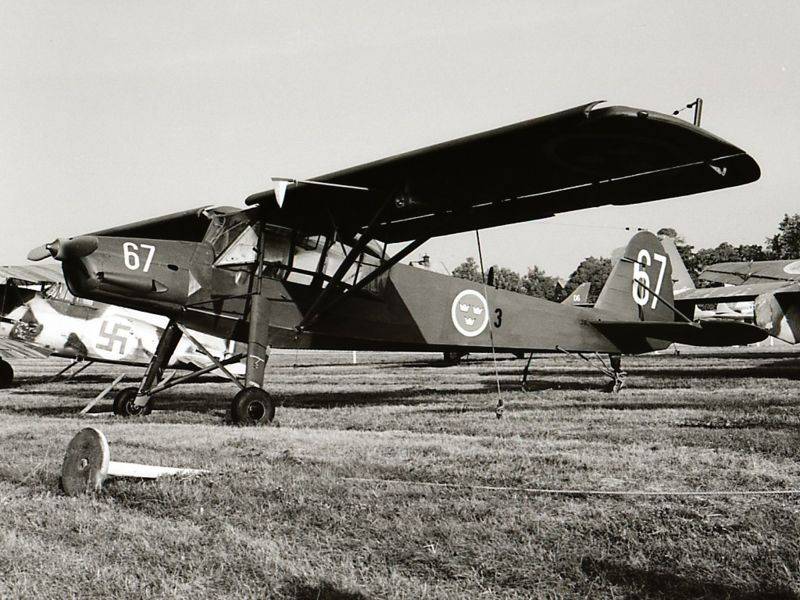
Swedish Air Force Fi 156
In addition to government agencies, a certain amount of Fi 156 was owned by private companies and individuals.
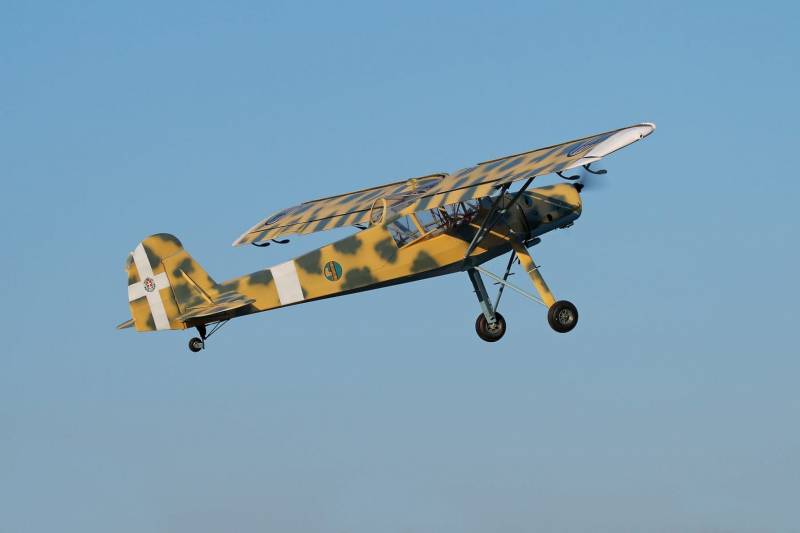
The French company Morane-Saulnier built slightly modified Fi 1965s until 156. The French Storch was named Criquet, and, depending on the year of manufacture, was equipped with various engines with a capacity of 233–304 hp. With.
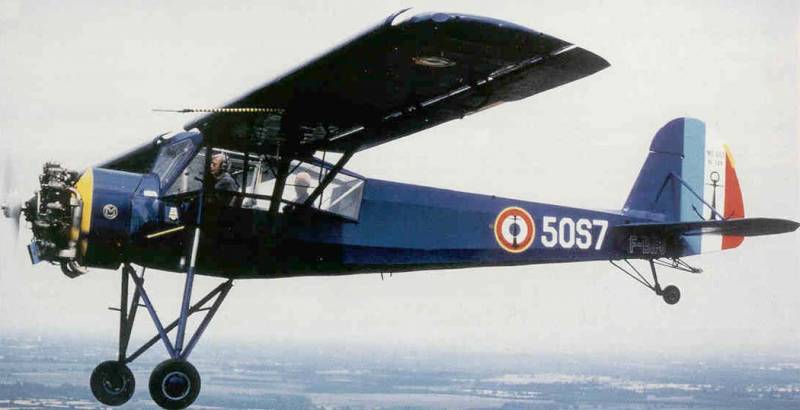
Morane-Saulnier MS-500 Criquet
The aircraft was produced in versions of a light reconnaissance-spotter with a crew of two, a communications aircraft with three seats and an ambulance. A number of machines received dual controls for training purposes.
After the evacuation of French troops from Southeast Asia, Criquet aircraft served with the air forces of Cambodia, Laos and South Vietnam.
In Czechoslovakia, the assembly of Storch aircraft continued until 1949. The Mráz plant in Chocen delivered 138 aircraft, known as the Mráz K-65 Čáp.
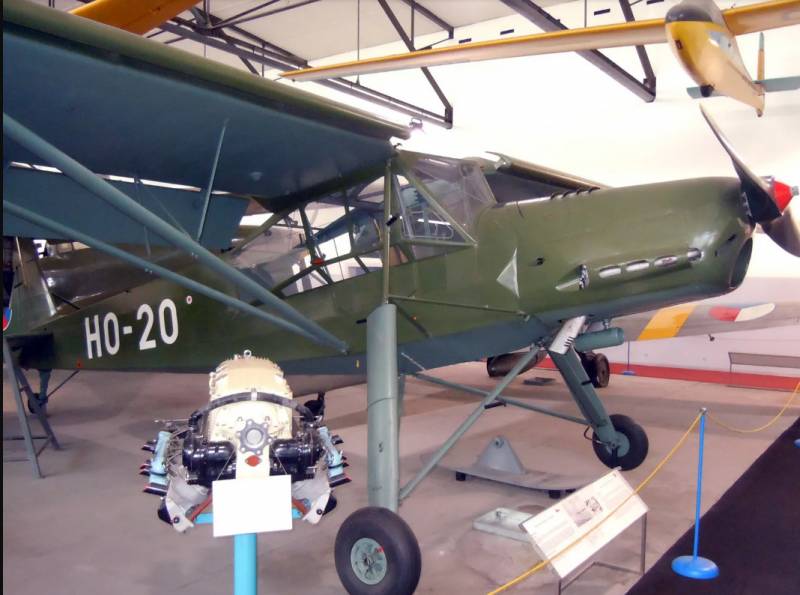
Mráz K-65 Čáp
Czechoslovakia exported 14 aircraft to Yugoslavia, where they flew until 1960. In Czechoslovakia itself, the last Mráz K-65 Čáp were written off in the late 1960s.
Focke-Wulf Fw 44 Stieglitz training aircraft
Before the advent of the Fw190 fighter, the most famous aircraft of Focke-Wulf Flugzeugbau GmbH was the two-seat light training biplane Focke-Wulf Fw 44 Stieglitz.
Testing of the prototype began in August 1932. The aircraft, equipped with a star-shaped 7-cylinder Bramo Sh 14A-4 engine, was a single-pillar biplane with a fuselage frame made of steel pipes and covered with fabric, a wooden wing with fabric and plywood sheathing.
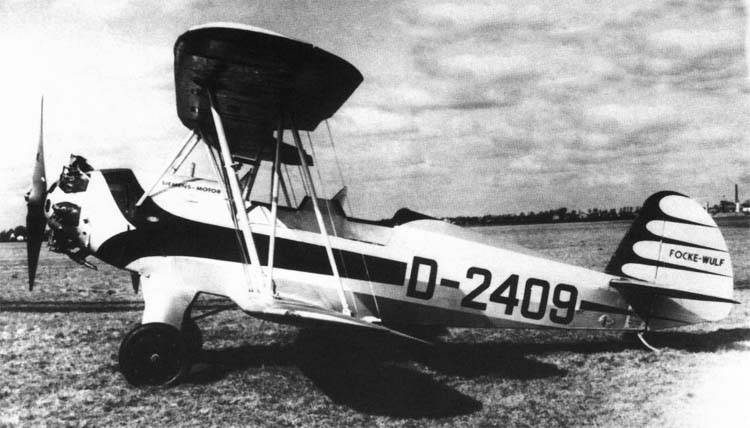
Fw 44 prototype
Refinement of the aircraft lasted until 1934, and in 1935 mass production began, which lasted in Germany until 1940. Quite leisurely tests by the standards of the 1930s and a thorough analysis of the identified shortcomings made it possible to bring the Stiglitz to a high level of technical excellence, which had a positive effect on reliability, durability and flight performance.
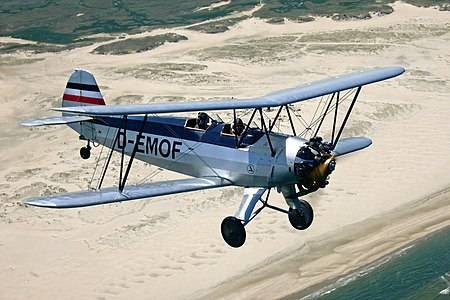
The plane turned out to be easy to fly and very maneuverable. The Fw 44 took part in numerous aerobatic competitions and demonstrations and was a hit with foreign buyers. Export orders came from Chile, Bolivia, China, Colombia, Czechoslovakia, Finland, Romania, Switzerland and Turkey.
Some countries bought a license to produce this aircraft. A large number of Fw 44s were available in Luftwaffe flight schools, where it was used as a trainer until the end of World War II.
The latest production modification, the Fw 44J, was also equipped with a BMW-Bramo Sh 14A-4 engine and had a maximum take-off weight of 900 kg. Maximum speed – 185 km/h. Cruising - 158 km/h. Practical range – 675 km. The practical ceiling is 3 km.
It was not possible to find information on the number of Fw 44 aircraft built; apparently, we are talking about thousands of copies.
After the end of World War II, in addition to the states that officially purchased Fw 44s from Germany and built them under license (Argentina, Bulgaria and Sweden), the operation of captured training biplanes continued in Czechoslovakia and Yugoslavia.
In the 1950s–1970s, a number of Fw 44s were sold to private individuals, and overhauled Stiglitz biplanes until recently delighted retro enthusiasts at aviation exhibitions and air shows.
Heinkel He 72 Kadett training aircraft
The Heinkel He 44 Kadett was used in much smaller quantities than the Fw 72 Stieglitz in Luftwaffe training units. But since captured biplanes of this type also flew in other countries in the post-war period, the Kadett deserves a separate story.
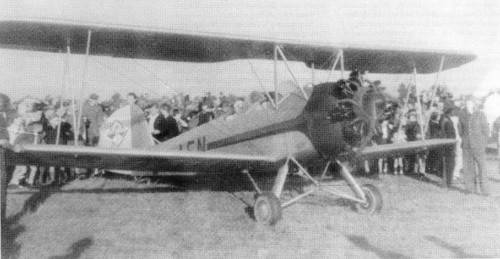
He 72
The He 72 Kadett was a mixed-construction biplane with fabric skin, open cockpits and fixed landing gear. The He 72B modification was equipped with a 7-cylinder air-cooled BMW-Bramo Sh 14 engine with a take-off power of 160 hp. With. The maximum take-off weight reached 865 kg. At an altitude of 1 m, the aircraft could accelerate in horizontal flight to 000 km. Cruising speed – 192 km. Practical range – 157 km. The practical ceiling is 820 km.
The He 72 was produced from March 1934 to September 1937. A total of 768 units were built. In addition to training and training, the He 72 was used as a communications aircraft and as a night bomber. As of May 1940, there were 629 He 72s in the Luftwaffe, and 1944 in January 417. Aircraft of this type were transferred to Bulgaria and Slovakia.
After the end of World War II, several He 72s were operated in Poland. Two dozen former Slovak He 72Ds called C-12s flew in Czechoslovakia until the mid-1950s.
Multipurpose aircraft Messerschmitt Bf. 108 Taifun
In many ways, the Messerschmitt Bf was a revolutionary vehicle for the mid-1930s. 108 Taifun, first flown in 1934. The aircraft was specially designed to participate in the 4th International Tourist Aircraft Competition, which took place from August 28 to September 16, 1934 in Warsaw.
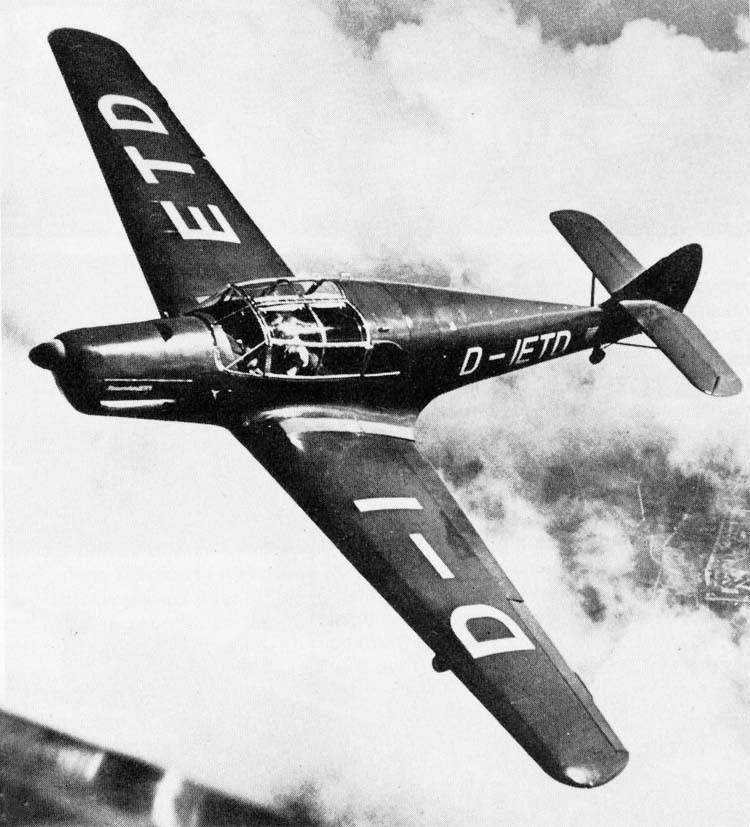
It was a cantilever monoplane with a low wing, retractable main landing gear and tail spike, and an enclosed four-seat cabin. Aircraft of the first batch of Bf. 108A were equipped with 8-cylinder air-cooled Hirth HM 8U engines with a power of 225 hp. With.
Four Bf. 108A that took part in the competition showed good results. This prompted the German Air Ministry to order 1935 Typhoons for civil aviation at the beginning of 32, and the possibility of using them in the Luftwaffe to deliver courier messages was also considered.
Deliveries of serial Bf. 108B began in 1935. Production continued until the beginning of 1944. The total number of Typhoons built in Germany and occupied France is approximately 890 units.
Airplane Bf. 108B with a maximum take-off weight of 1 kg, equipped with an Argus As 385C engine with a power of 10 hp. With. in horizontal flight it could accelerate to 240 km/h. Cruising speed was 300 km/h. Practical range – 262 km. Service ceiling – 950 m.
In the Luftwaffe, Typhoons were used mainly as courier aircraft, a number of Bf. 108 was used to train fighter pilots.
Before the start of World War II Bf. 108 were delivered to Hungary, China, Spain, USA, Chile, Switzerland, Yugoslavia and Japan. As part of German military assistance, Bulgaria and Romania received aircraft of this type.
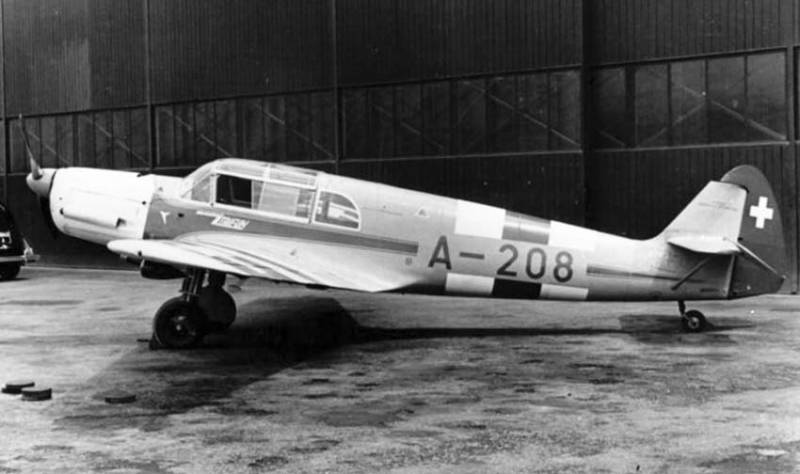
Four Bf. 108B, operated in Great Britain by private individuals, were confiscated by the British government after the outbreak of World War II. During World War II, Typhoons were considered the fastest communications vehicles of the Royal Air Force.
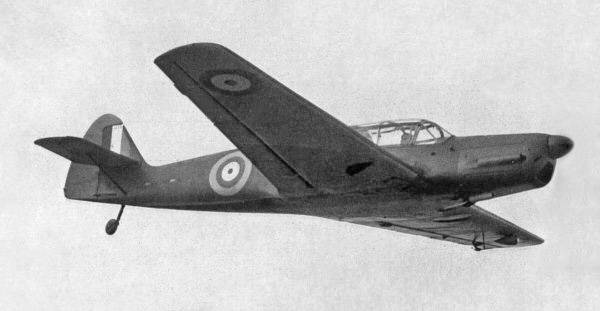
After the war, a further 15 captured Bf.108s flew in RAF colors until the mid-1950s.
Captured Typhoons also served in Poland, Norway, Czechoslovakia and France. Post-war French version, produced by SNCAN (Nord) with a Renault 6Q-11 engine producing 233 hp. s., known as Nord 1001 Pingoin I.
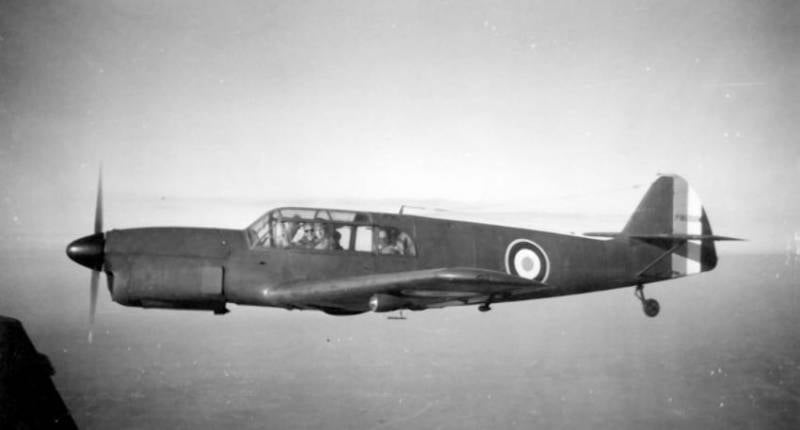
Nord 1001 Pingoin I
The Nord 1002 Pingouin II modification with a Renault 6Q-10 engine of the same power differed in that it had a more spacious interior.
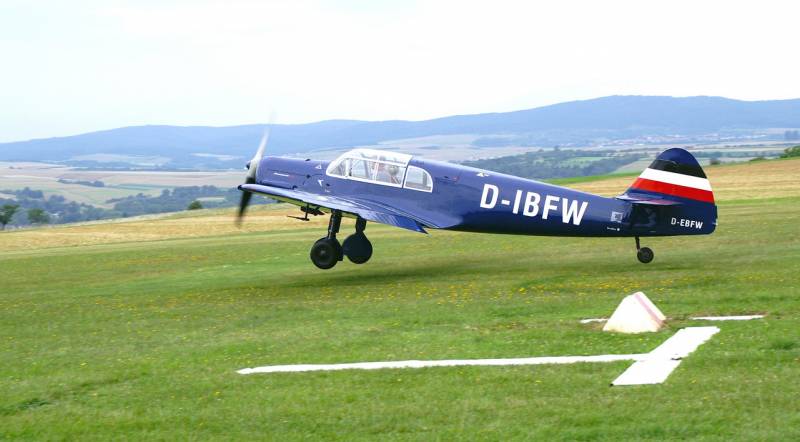
Several restored Bf aircraft. 108 and Nord Pingouin are still flying today.
Продолжение следует ...
Information